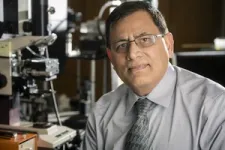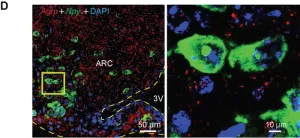(Press-News.org) A large international team led by astronomers at the Trottier Institute for Research on Exoplanets at Université de Montréal (UdeM) today announced in the journal Nature the discovery of a new temperate world around a nearby small star.
This planet, named LP 791-18 d, has a radius and a mass consistent with those of Earth. Observations of this exoplanet and another one in the same system indicate that LP 791-18 d is likely covered with volcanoes similar to Jupiter’s moon Io, the most volcanically active body in our Solar System.
“The discovery of this exoplanet is an extraordinary find,“ said Professor Björn Benneke from UdeM’s Department of Physics. “The similarity in the properties of LP 791-18 d and Earth as well as the prospect of detectable geological activity and volcanism on it make it a key object to better understand how terrestrial worlds form and evolve.”
Thanks to the very small size of the star – which is only slightly bigger than planet Jupiter – it should be possible to detect the atmosphere of this exoplanet, if it has one, using the James Webb Space Telescope.
A new terrestrial world in a multi-planetary system
The planet discovery was led by Merrin Peterson, a graduate student in Benneke’s team at the Trottier Institute. It was found and studied using data from NASA’s Spitzer Space Telescope and Transiting Exoplanet Survey Satellite (TESS), as well as a suite of ground-based observatories all over the world.
LP 791-18 d orbits a small red dwarf star about 86 light-years away in the southern constellation Crater. The Spitzer Telescope saw the star’s infrared light dim slightly when the planet passed in front of its disc a phenomenon called a transit. The observations of the system in October 2019 were among the last Spitzer collected before it was decommissioned.
Benneke’s team used the data to determine that the planet is virtually the same size as Earth. With an orbital period of only 2.8 days, the exoplanet LP 791-18 d is located very close to its host star. However, the star is much smaller and less bright than our Sun. The temperature on LP-791-18 d is thus only slightly higher than on Earth.
Astronomers have known about two other worlds in this system, planets LP 791-18 b and c, since 2019, when they were detected by the TESS satellite. Planet b is about 20% bigger than Earth and circles its star in a little less than a day, while Planet c is about 2.5 times Earth’s size and has a period of about 5 days. The newly found exoplanet d is thus the smallest in the family and orbits between planets b and c at an intermediate distance from the star.
Intense volcanic activity
By precisely tracking the movement of the planet, the team realised that planets c and d pass very close to each other as they trace their orbits. At their closest, they are only 1.5 million kilometres apart, which is 33 times closer than Mars and Earth ever get to each other. Each close passage between the planets produces a gravitational tug on planet d, making its orbit less circular and more elliptical. Along this elliptical path, planet d is slightly deformed every time it goes around the star. The astronomers computed that this deformation produces a lot of heat in the interior of the planet that needs to be transported to the surface via intense volcanic activity. Due to this phenomenon called tidal heating, LP 791-18 d is likely carpeted with volcanoes.
"The significant friction generated by tidal heating in the planet is responsible for heating its interior to a considerable extent, ultimately enabling the existence of a subsurface magma ocean," explained Caroline Piaulet, an UdeM Ph.D. student who was involved in the discovery. "In our Solar System, we know that Jupiter's moon Io is affected by Jupiter and its other moons in a similar way, and that world is the most volcanic we know."
Planet d sits on the inner edge of the temperate (or "habitable") zone, the traditional range of distances from a star where scientists hypothesise liquid water could exist on a planet’s surface. If the planet is as geologically active as UdeM’s team suspects, it could maintain an atmosphere. Given the right conditions, temperatures could even drop low enough on the planet’s night side for water to condense on the surface.
Measuring the masses of the planets
The proximity of Planets c and d also helped scientists measure their masses. When approached by Benneke with this discovery, many members of the TESS Follow-up Observing Program turned their ground-based telescopes to the LP 791-18 system, allowing them to collect observations of 67 transits from Planets c and d.
In these data, the team at UdeM was able to detect transit timing variations, which are slight differences in the exact times of the planets’ transits caused by the gravitational tug they exert on each other.
"This technique allowed us to estimate the masses of Planets c and d using only the transit data," Piaulet explained. "By combining this information with the size of the planets – an information readily available from the same data – we can estimate the density of the planets and thus get an idea of their composition and nature."
Comparing these values with planet interior models, astronomers were thus able to determine that the newly-found planet has a mass comparable to that of Earth. Its density is thus also consistent with a rocky composition like Earth. Planet c, which has a mass of about 7 times that of Earth's, has probably retained a significant amount of gas or lighter materials, akin to Neptune’s composition.
'Crucial to analyse the atmosphere'
Planet c, the largest of the system, has already been approved for observing time on the Webb Telescope, as part of the Canadian NEAT program, dedicated to the study of exoplanets. Pierre-Alexis Roy, another Ph.D. student on Benneke’s team at UdeM, will be in charge of analysing these observations. "Having a precise constraint on the mass of Planet c will be crucial to analyse the substantial atmosphere we're expecting to find on this mini-Neptune", he explains.
In the future, the small size of the star may even allow the detection of a much less extended atmosphere on the newly found planet d. Scientists expect that an atmosphere like that of the Earth, Venus, or Saturn's moon Titan could exist on Planet d. This system represents an unparalleled opportunity to learn more about small rocky planets, much like the TRAPPIST-1 system, which hosts seven Earth-sized planets, and is already being closely scrutinized by Webb.It is thus a prime target for Webb in the next few years that represents a similar opportunity to the TRAPPIST-1 system, which hosts seven Earth-sized planets.
"This system provides astronomers with a precious laboratory for testing various hypotheses related to the formation and evolution of terrestrial planets,'' said Benneke. "The newly found planet d, an Earth-size world likely covered in volcanoes in a multiplanetary system, provides unprecedented opportunities to advance not only astronomy but many other fields of science, notably geology, planetary sciences, atmospheric sciences, and possibly astrobiology."
About this study
“A temperate Earth-sized planet with tidally-heated interior transiting an M6 star” by Merrin Peterson et al., was published on May 17, 2023, in Nature.
In addition to Merrin Peterson, Björn Benneke, Caroline Piaulet, and Pierre-Alexis Roy, members of the Trottier Institute for Research on Exoplanets at Université de Montréal, the team also includes Jonathan Gagné, an UdeM adjunct professor and scientific ddvisor at the Space for Life Montreal Planetarium and member of iREx; Mohamad Ali-Dib, a former Trottier postdoctoral fellow at iREx, now at NYU Abu Dhabi; Ryan Cloutier, a former iREx graduate student and now assistant professor at McMaster University; Lauren Weiss, a former Trottier postdoctoral fellow at iREx who is now assistant professor at the University of Notre Dame; as well as 66 other co-authors from the United States, France, Spain, Belgium, Japan and Morocco.
Source
NASA Goddard Space Flight Center and the Trottier Institute for Research on Exoplanets – Université de Montréal
END
Found: a likely volcano-covered terrestrial world outside the Solar System
2023-05-17
ELSE PRESS RELEASES FROM THIS DATE:
Odd cells found in lungs of patients with idiopathic pulmonary fibrosis
2023-05-17
A pair of internationally renowned stem cell cloning experts at the University of Houston is reporting their findings of variant cells in the lungs of patients with Idiopathic Pulmonary Fibrosis (IPF) which likely represent key targets in any future therapy for the condition.
IPF is a progressive, irreversible and fatal lung disease in which the lungs become scarred and breathing becomes difficult. The rapid development and fatal progression of the disease occur by uncertain mechanisms, but the most pervasive school of thought is that IPF arises from recurrent, subclinical lung ...
What did the earliest animals look like?
2023-05-17
For more than a century, biologists have wondered what the earliest animals were like when they first arose in the ancient oceans over half a billion years ago.
Searching among today's most primitive-looking animals for the earliest branch of the animal tree of life, scientists gradually narrowed the possibilities down to two groups: sponges, which spend their entire adult lives in one spot, filtering food from seawater; and comb jellies, voracious predators that oar their way through the world's oceans in search of food.
In a new study published this week in the journal Nature, researchers use a novel approach based on chromosome structure to come up with ...
Researchers pinpoint brain cells that drive appetite in obesity
2023-05-17
A team at the Garvan Institute of Medical Research has discovered a group of brain cells that boosts appetite when there is a prolonged surplus of energy in the body, such as excess fat accumulation in obesity.
The researchers discovered that these cells not only produced the appetite-stimulating molecule NPY, but they in fact made the brain more sensitive to the molecule, boosting appetite even more.
“These cells kickstart changes in the brain that make it more sensitive to even low levels of NPY when there is a surplus of energy in the body in the form of excess fat – driving appetite during obesity,” explains Professor Herbert Herzog, senior ...
Receipt of medications for chronic disease during the first 2 years of COVID-19
2023-05-17
About The Study: This study of 18.1 million beneficiaries of fee-for service Medicare found that, in contrast to in-person health services, receipt of medications for chronic conditions was relatively stable in the first 2 years of the COVID-19 pandemic overall, across racial and ethnic groups, and for community-dwelling patients with dementia. This finding of stability may hold lessons for other outpatient services during the next pandemic.
Authors: Nancy E. Morden, M.D., M.P.H., of the Geisel ...
Genetic associations between modifiable risk factors and Alzheimer disease
2023-05-17
About The Study: This genetic association study including 39,000 participants with clinically diagnosed Alzheimer disease (AD) and 401,000 control participants without AD found novel genetic associations between high high-density lipoprotein (HDL) cholesterol concentrations and high systolic blood pressure with higher risk of AD. These findings may inspire new drug targeting and improved prevention implementation.
Authors: Ruth Frikke-Schmidt, M.D., D.M.Sc., Ph.D., of Copenhagen University Hospital–Rigshospitalet in Copenhagen, is the corresponding author.
To access the embargoed study: Visit our For The Media website at this link https://media.jamanetwork.com/
(doi:10.1001/jamanetworkopen.2023.13734)
Editor’s ...
Radio signal reveals supernova origin
2023-05-17
In the latest issue of the journal Nature, astronomers from Stockholm University reveal the origin of a thermonuclear supernova explosion. Strong emission lines of helium and the first detection of such a supernova in radio waves show that the exploding white dwarf star had a helium-rich companion.
Supernovae of Type Ia are important for astronomers since they are used to measure the expansion of the Universe. However, the origin of these explosions has remained an open question. While it is established that the explosion is that of a compact ...
Are Earth and Venus the only volcanic planets? Not anymore.
2023-05-17
Imagine an Earth-sized planet that’s not at all Earth-like. Half this world is locked in permanent daytime, the other half in permanent night, and it’s carpeted with active volcanoes. Astronomers have discovered that planet.
The planet, named LP 791-18d, orbits a small red dwarf star about 90 light years away. Volcanic activity makes the discovery particularly notable for astronomers because volcanism facilitates interaction between a world’s interior and its exterior.
“Why is volcanism important? It is the major source contributing to a planetary atmosphere, and with an atmosphere you could have surface liquid water — a requirement for sustaining ...
A channel involved in pain sensation can also suppress it
2023-05-17
Pain is good. It’s the body’s way to keep an animal from harming itself or repeating a dangerous mistake. But sometimes the debilitating sensation can get in the way. So evolution has devised ways to tamp that response down under certain circumstances.
Researchers at UC Santa Barbara identified the pathway in fruit flies that reduces the sensation of pain from heat. Remarkably, just a single neuron on each side of the animal’s brain controls the response. What’s more, the molecule responsible for suppressing ...
Genetic research offers new perspective on the early evolution of animals
2023-05-17
A study published by MBARI researchers and their collaborators today in Nature provides new insights about one of the earliest points in animal evolution that happened more than 700 million years ago.
For more than a century, scientists have been working to understand the pivotal moment when an ancient organism gave rise to the diverse array of animals in the world today. As technology and science have advanced, scientists have investigated two alternative hypotheses for which animals—sponges or comb jellies, also known as ctenophores—were most distantly related to all other animals. Identifying this outlier—known as the sibling ...
Research spotlight: a conversational artificial intelligence program can generate credible medical information in response to common patient questions
2023-05-17
What was the question you set out to answer with this study?
ChatGPT, a new language processing tool driven by artificial intelligence (AI), provides conversational text responses to questions and can generate valuable information for enquiring individuals, but the quality of ChatGPT-generated answers to medical questions is currently unclear.
What Methods or Approach Did You Use?
We retrieved eight common questions and answers about colonoscopy from the publicly available webpages of three randomly-selected hospitals from the top-20 list of the US News & World Report Best Hospitals for Gastroenterology and Gastrointestinal Surgery.
We ...







